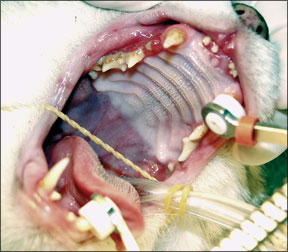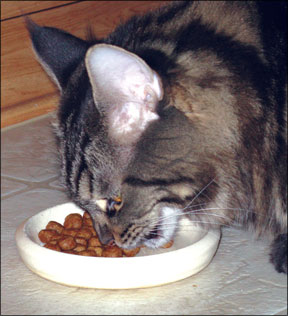It may surprise you to learn that dental disease is the most common disease in cats. In fact, approximately 50 percent of all cats show signs of gum and teeth problems by the time they reach adulthood. What is dental disease and what can you do to prevent it from happening to your cat?
Types of Dental Disease

Bev Caldwell
288
Periodontal disease – which includes gingivitis and periodontitis – is a serious condition that, when left untreated, can lead to tooth loss and may even cause damage to vital organs because bacteria from the mouth can circulate through the bloodstream.
Gingivitis is an inflammation of the gums that is caused when plaque bacteria accumulate on the tooth surface and in small pockets at the gumline called the gingival sulcus. According to Daniel Carmichael, DVM, a veterinary dentist at the Veterinary Medical Center in Islip, New York, “The gum tissue or gingiva senses the bacterial plaque, which causes the capillaries to dilate and bring in white blood cells, thus making the gums red, swollen and prone to bleeding.”
Although cats may exhibit symptoms of dental disease such as halitosis (bad breath), drooling, difficulty chewing, weight loss or lethargy, they usually will not show any obvious signs of pain. The good news is that gingivitis is often reversible with professional teeth cleaning at a veterinarians office and good oral home care. Untreated, however, gingivitis may often progress to periodontitis.
Periodontitis is caused when the bacteria in plaque spreads and proliferates below the gum line. The bacteria stimulate a chronic inflammatory response in which the body – via its defense mechanisms – essentially turns on itself. The tissues and bone that support the teeth begin to break down and the gums separate from the teeth, forming pockets. As the disease progresses, these pockets deepen and more gum tissue and bone are destroyed. Eventually, if treatment is not rendered, the teeth loosen and extraction becomes necessary.
Other forms of dental problems include feline odontoclastic resorptive lesions (FORLs) and feline gingivo stomatitis (FGS).
FORLs, or cat cavities, and are quite common, affecting over 70 percent of all cats. One of the classic signs of a cat cavity is an intense, but localized cherry-red inflammation right at the gum line, explains Dr. Carmichael, who also points out that cavities are extremely painful, especially for cats whose diets consist primarily of dry food. “If owners feeds their cats hard, crunchy food to control gingivitis, but the cat is actually suffering from cavities, its like rubbing salt into a wound.” Unlike cavities in people, a feline cavity cannot be filled; the only treatment option is extraction.
FGS is a serious, relatively uncommon disease that causes a cats mouth to become chronically inflamed due to an overreaction of the cats own immune system. Recent research has linked FGS to the calici virus, an upper respiratory viral disease in felines. The treatment of choice for FGS is extraction of most, if not all, of an affected cats teeth. One would assume that a cat without teeth is limited to a wet or soft-food diet, but thats not the case, according to Dr. Carmichael.
“The thing that prevents cats from eating dry food is not the

Bonnie Baker
288
presence or absence of teeth, but the presence or absence of pain and inflammation,” he says. “Cats without teeth can and do eat dry food and they do so fabulously.”
Treatment of Dental Disease
In the past, it was recommended that cats visit their veterinarian once a year for an examination and vaccinations. Today, many veterinarians like Dr. Carmichael recommend that all cats get a veterinary exam twice a year, which includes a thorough inspection of the gums and teeth at each visit.
“If you assume the old adage that one cat year equals seven human years, it would be like us going to the doctor once every three-and-a-half years,” he says. “In general, the best outcomes occur when disease is caught in its early stages; therefore, check-ups every six months are important.”
During an exam, the veterinarian may suggest that a cats teeth be cleaned while under anesthesia to remove built-up plaque and tartar and take care of any needed extractions or other dental treatments, such as advanced periodontal treatments or root canal therapy. It is necessary for the veterinarian to take dental radiographs to check for dental disease under the gum line. Make sure that your veterinarian has the proper equipment and capability needed to take dental X-rays before your cat is anesthetized.
“If the veterinarian doesnt have the necessary tools to diagnose and treat dental disease, go somewhere else,” says Dr. Carmichael.
Preventing Problems
Owners can help mitigate and perhaps even prevent dental disease from occurring by feeding their cat a specially-formulated feline dental diet that helps reduce plaque and tartar and brushing their cats teeth at home – a task that can prove challenging.
“There are very few cat owners who can successfully take care of their cats teeth at home,” says Dr. Carmichael, “although I once had a client who would unwind after a stressful day by brushing the teeth of her four Himalayan cats. She ordered cat toothpaste by the case.”
The consequences of untreated dental disease go way beyond bad breath; it can lead to painful oral infections, tooth loss, and the potential spread of bacteria to vital body organs such as the heart or liver. If you suspect that your cat is suffering from dental disease, seek the services of a veterinary dentist or a veterinarian who has a good working knowledge of dentistry to have your cats teeth evaluated.
“By taking good care of our cats teeth,” Dr. Carmichael says, “we can help them live better, longer lives.


